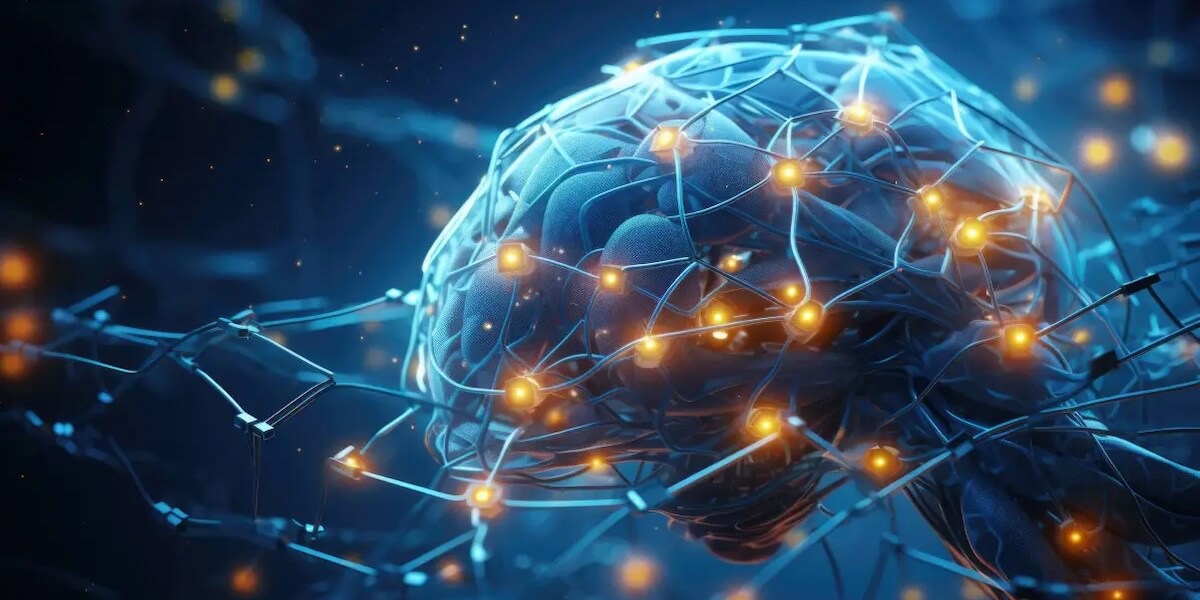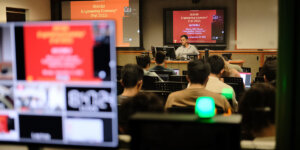
A USC Viterbi research team has discovered a new semiconductor with a unique property that will allow for energy efficient computers that function more like the human brain. Image/Unreal
Artificial intelligence is already transforming how we work and live, automating time-consuming tasks and streamlining our decision-making.
However, AI algorithms are mostly run on conventional complementary metal oxide semiconductor (CMOS)-based hardware. This requires them to be trained with large datasets to accomplish even the simplest tasks, such as image analysis or facial recognition. Processing these data-intensive requests requires vast computing resources, like data centers. The process consumes significant amounts of energy.
A USC Viterbi School of Engineering research team has discovered a new semiconductor with a unique material property that can enable more energy-efficient computing hardware that functions like the human brain. Two related research papers were published recently in the journals Advanced Materials and Advanced Electronic Materials. The research is led by Huandong Chen, a 2023 Materials Science Ph.D. graduate in the Mork Family Department of Chemical Engineering and Materials Science, from the group of Jayakanth Ravichandran, an associate professor in chemical engineering and materials science and electrical and computer engineering.
The human brain is excellent at associative learning — we have an innate ability to call up memories, make connections, and understand objects and stimuli in relation to each other. Human brains utilize interconnected neurons and synapses to store information locally where it is processed. Our brains are capable of handling highly sophisticated tasks and operating at remarkably low energy consumption. Developing neuromorphic computing hardware — hardware that mimics the architecture and operation of the human brain — is highly desired in the quest to achieve energy-efficient advanced computing.
Hardware materials that mimic the brain

Philip and Cayley MacDonald Endowed Early Career Chair Jayakanth Ravichandran.
If a material can move abruptly between two states (also known as phase transitions), this provides the foundation for hardware that mimics the brain. For example, a slight difference in temperature dramatically changes a material’s electrical conductivity — the ease of passing an electrical current — from a high to a low value, or vice versa. Such neuron-inspired phase change devices have been achieved only in a handful of materials.
The USC Viterbi researchers discovered novel electronic phase transitions in a semiconductor and leveraged those intriguing physical properties to demonstrate an abrupt electrical conductivity change with varying temperature and applied voltage, which can enable the development of energy-efficient neuromorphic computing.
Ravichandran holds the Philip and Cayley MacDonald Endowed Early Career Chair. His group has been working on a semiconductor material known as barium titanium sulfide (BaTiS3) since 2017. The group’s work resulted in the BaTiS3 material showing a world-record high birefringence property — a phenomenon in which a ray of light is split into two rays. In a recent unrelated work, they discovered an even higher value in a related material.
“However, as a semiconductor, we do not expect any abrupt phase transition in BaTiS3,” said Ravichandran.
“Naively thinking, this material should behave like a ‘boring’ semiconductor without any expectation of a phase transition,” said Chen.
A surprising discovery
Ravichandran and his group were surprised to observe the signatures of phase transitions in the BaTiS3 material when measuring its electrical properties under different temperatures. Upon cooling the material, the electrical resistivity of BaTiS3 increases, and it undergoes a transition at around 240 Kelvin (about -33° Celsius), featuring an abrupt change in electrical conductivity. With further cooling, it continues to increase until 150 Kelvin (about -123° Celsius), after which the material goes through another transition with increased electrical conductivity.
“It is always exciting to observe abnormal behavior in our experiments, but we have to check carefully to make sure that those phenomena are real and reproducible,” said Ravichandran.
In this work, Chen performed careful experiments to rule out contributions from many extrinsic factors, such as contact resistance and strain status, which could complicate this effect. It was demonstrated that the unique property originated within the material itself.

Postdoctoral researcher in the Ravichandran Group Huandong Chen
“This is particularly important when characterizing such a new material system. One good example of not ruling out other factors was the recent drama surrounding the so-called room temperature superconductor LK-99, where it seems the sharp drop in resistivity at around 105° Celsius is likely from an impurity, known as Cu2S”, said Chen.
The team also investigated how the crystal structure of the BaTiS3 material changes during these electronic phase transitions, corresponding to the changes in electrical conductivity.
Boyang Zhao, a Materials Science Ph.D. candidate from Ravichandran’s group, traveled to the synchrotron at Lawrence Berkeley National Lab to map out the structure evolution. By combining the information from the electrical and structural measurements — which are key experimental features for the interesting phenomena called charge density wave phase transition — the team could claim the existence of charge density wave order in BaTiS3.
“We’ve discovered one very special charge density wave phase change material. Most charge density wave materials only go from a metal state — which is high conductivity to an insulator state — which is low conductivity. What we have found is that you can go from a low conductivity state to a low conductivity state. Such insulating-to-insulating transition is very, very rare, with only a handful of examples out there. So, scientifically, it’s very interesting,” said Ravichandran.
How the phase transitions in BaTiS3 work is not fully understood yet. The team collaborated with Rohan Mishra’s group from Washington University in St. Louis, performing materials modeling to obtain a deeper understanding of the material system. Current experimental and theoretical findings suggest that the observed phase change phenomena have an unexpected origin compared to most charge density wave materials. The team is conducting further studies to understand this phenomenon better.
The latest Advanced Materials research on novel phase change material discovery was conducted with collaborators from the University of Washington in Seattle, Washington University in St. Louis, Columbia University, Oak Ridge National Laboratory, and Lawrence Berkley National Laboratory.
A prototype showing the material in action
In a follow-up work that was recently published in Advanced Electronic Materials, Chen and his collaborators fabricated the first prototype neuronal device using the BaTiS3 material. They were able to show abrupt switching by varying current and voltage. They also showed oscillations in voltage that signified fast switching between two states in the phase transition. Similar voltage oscillations are observed in the brain.
“This is an important step towards actual electronic device applications of BaTiS3. It is also quite exciting to see such a short period of time between this prototype device demonstration and the fundamental material property discovery,” said Chen.
The frequency of voltage oscillations was altered by the operation temperature and channel sizes. A lower operation temperature and a shorter device channel size give rise to higher oscillation frequencies.
“We expect that much more sophisticated neuronal functionalities can be achieved by connecting multiple BaTiS3 neurons to each other or integrating with other passive synaptic devices, as has been successfully demonstrated in another phase change system VO2. Future efforts in making this material in the thin film form that features phase transitions and is potentially compatible with our semiconductor manufacturing could be of great interest to both the research community and the semiconductor industry,” said Chen.
This work in Advanced Electronic Materials was done in collaboration with Robert G. and Mary G. Lane Endowed Early Career Chair Han Wang’s group in USC’s Ming Hsieh Department of Electrical and Computer Engineering. Other authors include Materials Science Ph.D. candidate Nan Wang and Electrical Engineering Ph.D. candidate Hefei Liu.
Ravichandran serves as a co-director for the Core Center of Excellence in NanoImaging (CNI).
Ravichandran and his research team at USC are supported by the MURI program of the Army Research Office and the U.S. National Science Foundation’s Ceramics Program.
Published on November 14th, 2023
Last updated on November 14th, 2023











